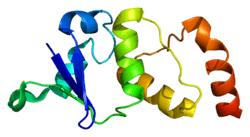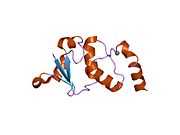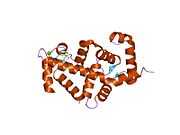KCND2
Potassium voltage-gated channel subfamily D member 2 is a protein that in humans is encoded by the KCND2 gene.[1][2][3] It contributes to the cardiac transient outward potassium current (Ito1), the main contributing current to the repolarizing phase 1 of the cardiac action potential.[4]
Description
Voltage-gated potassium (Kv) channels represent the most complex class of voltage-gated ion channels from both functional and structural standpoints. Their diverse functions include regulating neurotransmitter release, heart rate, insulin secretion, neuronal excitability, epithelial electrolyte transport, smooth muscle contraction, and cell volume. Four sequence-related potassium channel genes - shaker, shaw, shab, and shal - have been identified in Drosophila, and each has been shown to have human homolog(s). This gene encodes a member of the potassium channel, voltage-gated, shal-related subfamily, members of which form voltage-activated A-type potassium ion channels and are prominent in the repolarization phase of the action potential. This member mediates a rapidly inactivating, A-type outward potassium current which is not under the control of the N terminus as it is in Shaker channels.[3]
Interactions
KCND2 has been shown to interact with FLNC.[5]
See also
References
- ↑ Zhu XR, Wulf A, Schwarz M, Isbrandt D, Pongs O (December 1999). "Characterization of human Kv4.2 mediating a rapidly-inactivating transient voltage-sensitive K+ current". Receptors Channels 6 (5): 387–400. PMID 10551270.
- ↑ Gutman GA, Chandy KG, Grissmer S, Lazdunski M, McKinnon D, Pardo LA, Robertson GA, Rudy B, Sanguinetti MC, Stuhmer W, Wang X (December 2005). "International Union of Pharmacology. LIII. Nomenclature and molecular relationships of voltage-gated potassium channels". Pharmacol Rev 57 (4): 473–508. doi:10.1124/pr.57.4.10. PMID 16382104.
- ↑ 3.0 3.1 "Entrez Gene: KCND2 potassium voltage-gated channel, Shal-related subfamily, member 2".
- ↑ Oudit GY, Kassiri Z, Sah R, Ramirez RJ, Zobel C, Backx PH (May 2001). "The molecular physiology of the cardiac transient outward potassium current (I(to)) in normal and diseased myocardium". J. Mol. Cell. Cardiol. 33 (5): 851–872. doi:10.1006/jmcc.2001.1376. PMID 11343410.
- ↑ Petrecca, K; Miller D M; Shrier A (December 2000). "Localization and enhanced current density of the Kv4.2 potassium channel by interaction with the actin-binding protein filamin". J. Neurosci. (UNITED STATES) 20 (23): 8736–44. PMID 11102480.
Further reading
- Kong W; Po S; Yamagishi T et al. (1999). "Isolation and characterization of the human gene encoding Ito: further diversity by alternative mRNA splicing". Am. J. Physiol. 275 (6 Pt 2): H1963–70. PMID 9843794.
- Kikuno R; Nagase T; Ishikawa K et al. (1999). "Prediction of the coding sequences of unidentified human genes. XIV. The complete sequences of 100 new cDNA clones from brain which code for large proteins in vitro". DNA Res. 6 (3): 197–205. doi:10.1093/dnares/6.3.197. PMID 10470851.
- Kurschner C, Yuzaki M (1999). "Neuronal interleukin-16 (NIL-16): a dual function PDZ domain protein". J. Neurosci. 19 (18): 7770–80. PMID 10479680.
- An WF; Bowlby MR; Betty M et al. (2000). "Modulation of A-type potassium channels by a family of calcium sensors". Nature 403 (6769): 553–556. doi:10.1038/35000592. PMID 10676964.
- Isbrandt D; Leicher T; Waldschütz R et al. (2000). "Gene structures and expression profiles of three human KCND (Kv4) potassium channels mediating A-type currents I(TO) and I(SA)". Genomics 64 (2): 144–154. doi:10.1006/geno.2000.6117. PMID 10729221.
- Postma AV; Bezzina CR; de Vries JF et al. (2000). "Genomic organisation and chromosomal localisation of two members of the KCND ion channel family, KCND2 and KCND3". Hum. Genet. 106 (6): 614–619. doi:10.1007/s004390050033. PMID 10942109.
- Petrecca K, Miller DM, Shrier A (2001). "Localization and enhanced current density of the Kv4.2 potassium channel by interaction with the actin-binding protein filamin". J. Neurosci. 20 (23): 8736–44. PMID 11102480.
- Bähring R; Dannenberg J; Peters HC et al. (2001). "Conserved Kv4 N-terminal domain critical for effects of Kv channel-interacting protein 2.2 on channel expression and gating". J. Biol. Chem. 276 (26): 23888–23894. doi:10.1074/jbc.M101320200. PMID 11287421.
- Nakamura TY; Pountney DJ; Ozaita A et al. (2001). "A role for frequenin, a Ca2+-binding protein, as a regulator of Kv4 K+-currents". Proc. Natl. Acad. Sci. U.S.A. 98 (22): 12808–12813. doi:10.1073/pnas.221168498. PMC 60135. PMID 11606724.
- Morohashi Y; Hatano N; Ohya S et al. (2002). "Molecular cloning and characterization of CALP/KChIP4, a novel EF-hand protein interacting with presenilin 2 and voltage-gated potassium channel subunit Kv4". J. Biol. Chem. 277 (17): 14965–14975. doi:10.1074/jbc.M200897200. PMID 11847232.
- Eldstrom J, Doerksen KW, Steele DF, Fedida D (2002). "N-terminal PDZ-binding domain in Kv1 potassium channels". FEBS Lett. 531 (3): 529–537. doi:10.1016/S0014-5793(02)03572-X. PMID 12435606.
- Schrader LA; Anderson AE; Mayne A et al. (2002). "PKA modulation of Kv4.2-encoded A-type potassium channels requires formation of a supramolecular complex". J. Neurosci. 22 (23): 10123–33. PMID 12451113.
- Strausberg RL; Feingold EA; Grouse LH et al. (2003). "Generation and initial analysis of more than 15,000 full-length human and mouse cDNA sequences". Proc. Natl. Acad. Sci. U.S.A. 99 (26): 16899–16903. doi:10.1073/pnas.242603899. PMC 139241. PMID 12477932.
- Shin BK; Wang H; Yim AM et al. (2003). "Global profiling of the cell surface proteome of cancer cells uncovers an abundance of proteins with chaperone function". J. Biol. Chem. 278 (9): 7607–7616. doi:10.1074/jbc.M210455200. PMID 12493773.
- Scherer SW; Cheung J; MacDonald JR et al. (2003). "Human chromosome 7: DNA sequence and biology". Science 300 (5620): 767–772. doi:10.1126/science.1083423. PMC 2882961. PMID 12690205.
- Hillier LW; Fulton RS; Fulton LA et al. (2003). "The DNA sequence of human chromosome 7". Nature 424 (6945): 157–164. doi:10.1038/nature01782. PMID 12853948.
- Wong W, Schlichter LC (2004). "Differential recruitment of Kv1.4 and Kv4.2 to lipid rafts by PSD-95". J. Biol. Chem. 279 (1): 444–452. doi:10.1074/jbc.M304675200. PMID 14559911.
- Kim LA; Furst J; Butler MH et al. (2004). "Ito channels are octomeric complexes with four subunits of each Kv4.2 and K+ channel-interacting protein 2". J. Biol. Chem. 279 (7): 5549–5554. doi:10.1074/jbc.M311332200. PMID 14623880.
External links
- Kv4.2 Potassium Channel at the US National Library of Medicine Medical Subject Headings (MeSH)
- KCND2 protein, human at the US National Library of Medicine Medical Subject Headings (MeSH)
| |||||||||||
| ||||||||||||||||||||||||||||||||||||||||||||||||||||||||||||||||||||||||||||||||||||||||||||||||||||||||||||||||||||||||
This article incorporates text from the United States National Library of Medicine, which is in the public domain.


